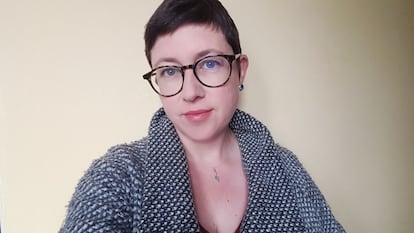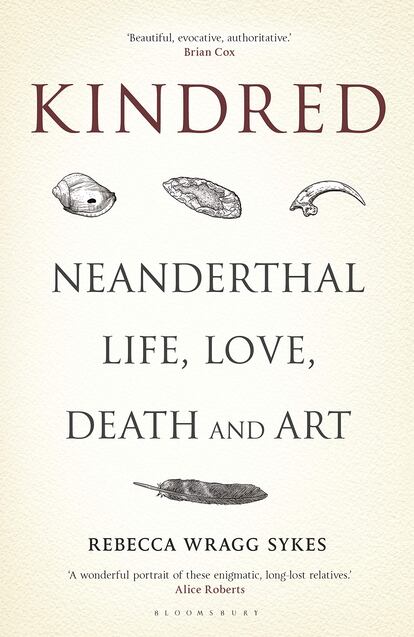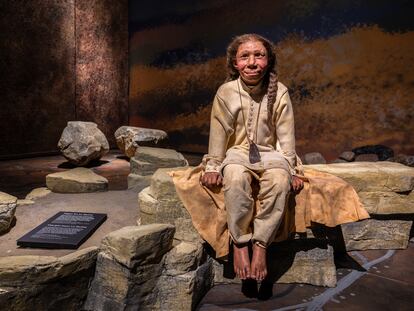Rebecca Wragg Sykes: ‘Neanderthals were very successful at what they did, they were not failures’
The author of ‘Kindred,’ an authoritative book about our extinct relatives, talks to EL PAÍS about some of the great discoveries made by the species and the prejudices that still exist against them

The relationship between the Neanderthals and this world was born around 350,000 years ago. The relationship between Rebecca Wragg Sykes and the Neanderthals began when she was just 14 years old. During a visit organized by her school, Sykes was able to see first-hand the work carried out on a Roman-era archeological site. “That was when I realized that I wanted to study archeology,” she explains.
Years later, a video shown at the Altamira Cave Museum in northern Spain prompted her to turn her attention to her true passion. Roman remains were all well and good, but the Pleistocene geological epoch was a much more “exciting” field. “We don’t have text, we have no written records. But also even compared to later prehistory, we don’t have as much stuff so we have to be even more inventive in pulling out as much information as possible,” Sykes explains during an interview with EL PAÍS via videoconference.
Fifteen years of studies have been condensed into her book, Kindred: Neanderthal Life, Love, Death and Art, which arrived in Spanish bookstores today, September 1 (Neandertales: la vida, el amor, la muerte y el arte de nuestros primos lejanos, published by Editorial GeoPlaneta), and which The New York Times included on its list of 100 best books of 2020. The book does “a remarkable job synthesizing thousands of academic studies into a single accessible narrative,” the US daily said about it in one of its reviews. The aim is to bring to the general public all of the recent discoveries about Neanderthals, but also other details about their lives and their day-to-day activities that are not usually covered in conventional media.
Question. What was your objective when writing the book?
Answer. Neanderthals are interesting because they are in the media a lot – like I usually say, they’re like A-list celebrities for hominins. If there is a Neanderthal discovery, often it is covered in the media. What’s not covered is masses of other information that we as archeologists know about. But that is difficult to write up in one short article. So I wanted to write a book that brought together the entirety of what modern archeology can say about Neanderthals, including the big discoveries, but also how archeology works now and all the different threads in what we do and how we bring it together to create this this really rich understanding of Neanderthal life, which I think is often not communicated outside some of the main themes that tend to be on television or in big newspaper reports. It is often about extinction, and I wanted to talk about the rest of the Neanderthal, 300,000 years before that happened, because that’s also very interesting. I wanted to think about them on their own terms, without having us in the background saying what came after.
Q. And how was the process, with the pandemic in between?
A. I started talking to my publisher about it eight years ago, and it actually took me three and a half years to write the book. I started writing it in 2017 while I was still in France, and then I moved back to the UK. Although it’s a really wonderful experience to write for popular science where you can just really pursue your passion, it’s difficult to transition to that from academic writing where you think that you have to put every single example of something in to prove your point. And so I had to restructure the book once, and it was twice the length it is at one point. So the actual process of writing was difficult, although I really liked writing the introductions to the chapters, they are sort of the whole narrative. Obviously for me [the pandemic] was difficult, but compared to what other people were dealing with professionally during that time… At the end of the book, I do mention Covid and the pandemic, because the epilogue was already focusing on quite existential questions about the climate crisis and how people are worrying about that, and it is real and it’s frightening. The pandemic was another element that really sort of helped finish that aspect of the book, underlining to me how chance and luck plays such a key role in what happens to us at a species level.

Q. One of the most interesting anecdotes is the origin of the name Neanderthal. Where does it come from?
A. This is one of those strange historical connections. There are a lot of old things in the history of archeology and I didn’t even include some of them because they’re just extra strange. There was a Neanderthal skull stored under an altar in a Catholic church in Rome at one point during the war [laughs]. Just very weird things. But the naming of the Neanderthal as a species – originally it comes from the Feldhofer cave in Germany, which is in the Neandertal, so the Neander Valley. That valley was named after a composer from the 1600s [Joachim Neander] and it only really got that name one hundred years or so after he died. It was very beautiful. It was a tourist spot. People used to love to visit there and sort of be inspired – musicians and artists – and he used to visit there. And some of his work may have been inspired by being in that landscape. But at that point in the 1600s, there was not an understanding of Pleistocene geology and things like this. So occasionally people would find bits of mammoth and call them “giants.” In the 19th century a quarry in that valley began to extract limestone marble. And that’s when the cave was found and cleared out in advance of the mining, and that’s when the bones were found. But the very strange thing is that this guy’s family name was Neander, which was a version of Neumann, which means “new man.” So you couldn’t think of a better place really.
Q. Reading the book, you get the feeling that we know everything about Neanderthals. Is that right?
A. There is so much we don’t know. We don’t know the eastern extent of where they lived. The easternmost site is the Denisova cave in Siberia. But just because that’s the furthest we found doesn’t mean that’s the furthest they went. So between Denisova and the Pacific, there is just steppe and some mountains, but there is no reason why they couldn’t have gone significantly further east. We don’t know how far they actually moved as individuals in their groups. We only have two ways of measuring that. We can look at isotopes in their bones, which tells us so far – because we don’t have many samples – that they were moving 50 kilometers or so from where they were born. But that might not be a real measure. And the only other way we can do it is by sourcing the stone of the tools that they made and saying, well, this tool came from a mountain one hundred kilometers over there, or three hundred kilometers. And when you have those big distances, does that mean that individual Neanderthals were moving over that scale or are they giving things, or are objects being exchanged? We don’t know at the moment.
We don’t know why the particular groups are using particular kinds of technology. And did all groups know how to make all kinds of technology? That’s very difficult to say. If you have a very well preserved site you can say amazing things about what was going on there, how that site is connected to other places in the landscape. But there are still some fundamental aspects of their lives that we don’t know about. We don’t know about their kind of mating system. Did they move between groups? How often did that happen? It’s hard to say. We can look at individual sites and say, well, at this site, maybe they weren’t moving between groups very much. But to try and then say they all were doing that is difficult because they lived through such a huge span of time and over a very wide area. So I think what we’re getting better at is understanding that we should expect diversity in what they were doing.
Q. The book also seeks to do away with the clichés about Neanderthals. Why are those clichés so deep-rooted?
A. It’s something strange because Neanderthals were the first hominin that we found. They were the first time we knew there was another sort of human that had been on the planet. They have been held up as something to compare us to from the very start of human origins as a science. So I think in that sense, we’ve always been quite keen to look at the differences and to underline why they are rubbish, basically, and to have a negative view, because we want to explain why they’re not here other than in genetics inside us. There are no Neanderthals walking around and we want to explain that in a way that puts us in a good light, because that’s how we often frame our explanations for things. So there is definitely a persistent negative view and it is there in science, but also in culture. But on the other hand, when I meet people on a train and we talk and they find out that I work on Neanderthals, quite often, people will say to me, “Oh, they’re not as stupid as we used to think.” But people are still happy to use the word Neanderthal as an insult. It’s become separate from the archeology and the insult is still there.
Q. But Neanderthals lived in groups, they cared about each other, they worried about art, languages, communication. So you might think that we are not too far away from them.
A. If you look at what Homo sapiens were doing around the same time Neanderthals were alive, for most of that period between 350,000 to 40,000, for most of that time the archeology looks really, really similar. There’s very little difference. It’s only somewhat later, after 100,000 years, maybe after 60,000 years that you start to see some differences in the esthetics and also possibly in things like hunting technology. [...] One of the key differences that may have made a difference in terms of extinction was that Homo sapiens groups had a different social organization. We have evidence from the archeology that there are more symbolic objects and also from the genetics – it suggests that those early Homo sapiens groups were not isolated from each other. They were living in small numbers, but they were well connected. And that looks very much like what you see in recent hunting and gathering populations like, say, Australian Aboriginal people or hunter gatherer populations in Africa, where people move between their groups all the time. Many of those people may not be blood relations. They are kin. They have a kin network that is very extensive and that may be what Neanderthals didn’t have. So I think it’s something to do with the social networks between early Homo sapiens people. That is perhaps a really key difference.
Q. The Neanderthals were nearly as intelligent as we were, but they still disappeared. Can we learn something from that?
A. I think they had an impressive intelligence and in many ways it’s the same. But perhaps they didn’t think about the world in exactly the same way as us, and this idea of networks between people, perhaps they didn’t make as many connections between ideas. I think you need to think that they were very successful at what they did. They were not failures at being hunting and gathering people. They were very good at it. I think it’s a good comparison to look at the deep history of the Earth and previous mass extinction events, and quite often there are other animals who were very well adapted to their environment and they still become extinct. And there is really an element of luck. I think that we do have to ask, why did it take so long? Because we know that early Homo sapiens were leaving Africa 150,000 or 200,000 years ago. If we were so superior, why did it take us so long to replace Neanderthals and even to get into Europe? Why was that happening so much later when actually what we see from that long period is that there definitely were meetings because we can see it in the genetics. We know there was interbreeding, but something is definitely different towards the end. And luck may be part of that – perhaps our desire to connect with each other, and to socialize. it doesn’t make us cleverer. It just makes us different. And that may have been what helped, I think.
Tu suscripción se está usando en otro dispositivo
¿Quieres añadir otro usuario a tu suscripción?
Si continúas leyendo en este dispositivo, no se podrá leer en el otro.
FlechaTu suscripción se está usando en otro dispositivo y solo puedes acceder a EL PAÍS desde un dispositivo a la vez.
Si quieres compartir tu cuenta, cambia tu suscripción a la modalidad Premium, así podrás añadir otro usuario. Cada uno accederá con su propia cuenta de email, lo que os permitirá personalizar vuestra experiencia en EL PAÍS.
¿Tienes una suscripción de empresa? Accede aquí para contratar más cuentas.
En el caso de no saber quién está usando tu cuenta, te recomendamos cambiar tu contraseña aquí.
Si decides continuar compartiendo tu cuenta, este mensaje se mostrará en tu dispositivo y en el de la otra persona que está usando tu cuenta de forma indefinida, afectando a tu experiencia de lectura. Puedes consultar aquí los términos y condiciones de la suscripción digital.
More information
Archived In
Últimas noticias
Most viewed
- Sinaloa Cartel war is taking its toll on Los Chapitos
- Oona Chaplin: ‘I told James Cameron that I was living in a treehouse and starting a permaculture project with a friend’
- Reinhard Genzel, Nobel laureate in physics: ‘One-minute videos will never give you the truth’
- Why the price of coffee has skyrocketed: from Brazilian plantations to specialty coffee houses
- Silver prices are going crazy: This is what’s fueling the rally










































